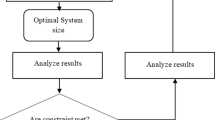Abstract
This paper presents power management of an educational institution which is located in Bhimavaram, India. The institution is assumed as commercial load which is fed from an 11KV line the load deviations are mainly considered throughout the day time merely because of the institution’s working hours. This optimization comes with a bidirectional power flow from institution to the grid and grid to the institution. With a renewable power generation of solar plant with 100 kW generation the optimal power utilization is proposed such that the effective usage of renewable energy increases and the usage of fossil fuel-based generators decrease. In homer software the optimization of the given projected system is accomplished through simulation.











Similar content being viewed by others
References
Lambert T,Gilman P, Lilienthal P. 2006, Micro power system modeling with homer. Integration of alternative sources of energy. John Wiley& Sons, Inc, p. 379–418.
Bernal-Agustín JL, Dufo-López R (2009) Simulation and optimization of stand-alone hybrid renewable energy systems. Renew Sustain Energy Rev 13:2111–2118
Erdinc O, Uzunoglu M (2012) Optimum design of hybrid renewable energy systems: overview of different approaches. Renew Sustain Energy Rev 16:1412–25
Türkay BE, Telli AY (2011) Economic analysis of standalone and grid connected hybrid energy systems. Renew Energy 36:1931–1943
Hafez O, Bhattacharya K (2012) Optimal planning and design of a renewable energy-based supply system for microgrids. Renew Energy 45:7–15
Rehman S, Mahbub Alam M, Meyer JP, Al-Hadhrami LM (2012) Feasibility study of a wind–pv–diesel hybrid power system for a village. Renew Energy 38:258–268
FathimaAH PK (2015) Optimization in microgrids with hybrid energy systems—a review. Renew Sustain Energy Rev 45:431–446
Kaundinya DP, Balachandra P, Ravindranath NH (2009) Grid-connected versus stand-alone energy systems for decentralized power—a review of literature. Renew Sustain Energy Rev 13:2041–50
Mahesh A, Sandhu KS (2015) Hybrid wind/ photovoltaic energy system developments: critical review and findings. Renew Sustain Energy Rev 52:1135–1147
Khan MJ, Iqbal MT (2005) Pre-feasibility study of stand-alone hybrid energy systems for applications in New found land. Renew Energy 30:835–54
Nfah EM, Ngundam JM, Vandenbergh M, Schmid J (2008) Simulation of off-grid generation options for remote villages in Cameroon. Renew Energy 33:1064–1072
Camblong H, SarrJ NiangAT, CureaO AlzolaJA, Sylla EH et al (2009) Micro-grids project, Part1:analysis of rural electrification with high content of renewable energy sources in Senegal. Renew Energy 34:2141–50
Alzola JA, CamblongVechiu HI, SallSantos MM, Sow G (2009) Microgrids project, Part 2: Design of an electrification kit with high content of renewable energy sources in Senegal. Renew Energy 34:2151–9
Li C, ZhengGe YX, RenXu YC, Song C et al (2013) Techno-economic feasibility study of autonomous hybrid wind/PV/battery power system for a household in Urumqi, China. Energy 55:263–72
Ashourian MH, Cherati SM, MohdZin AA, Niknam N, Mokhtar AS, Anwari M (2013) Optimal green energy management for island resorts in Malaysia. Renew Energy 51:36–45
Dalton GJ, Lockington DA, Baldock TE (2009) Feasibility analysis of renewable energy supply options for a grid-connected large hotel. Renew Energy 34:955–964
Sharma, Yash, Bharat Kumar Saxena, and Sanjeev Mishra. 2019, "Techno-Economic Analysis of Rooftop Solar PV System by Variation in PV Module Capacity." 2019 2nd International Conference on Power and Embedded Drive Control (ICPEDC). IEEE.
Costa, Tatiane Silva, Marcelo Gradella Villalva. (2020), "Technical Evaluation of a PV-Diesel Hybrid System with Energy Storage: Case Study in the Tapajós-Arapiuns Extractive Reserve, Amazon, Brazil." Energies, 13.11: 2969.
Acknowledgement
The authors thank the authorities of SRKR Engineering College for providing necessary facilities to complete this work. The authors acknowledge the authorities of the DST for having provided the necessary facilities in the form of HOMER PRO software through the PURSE II Program to the Centre for Renewable Energy in the Engineering and Technology Faculty at Annamalai University.
Author information
Authors and Affiliations
Corresponding author
Additional information
Publisher's Note
Springer Nature remains neutral with regard to jurisdictional claims in published maps and institutional affiliations.
Rights and permissions
About this article
Cite this article
Pothula Jagadeesh, Mohamed Thameem Ansari, M. & Saiveerraju, M. Optimal Power Management of an Educational Institution Using HOMER. J. Electr. Eng. Technol. 16, 1793–1798 (2021). https://doi.org/10.1007/s42835-021-00713-9
Received:
Revised:
Accepted:
Published:
Issue Date:
DOI: https://doi.org/10.1007/s42835-021-00713-9




